Base Camp Monpazier
What do you call a 14 kilometre paddle downstream in a two-man canoe? Answer – a relationship test! It’s a skills test on the art of teamwork and we’ve failed. Out on the Dordogne River in France’s south-west on a warm sunny day, a leisurely canoe trip seemed like an idyllic pastime. The picturesque villages of La Roque Gageac, Beynac and Castelnaud line the banks of the river, overlooked by historic imposing fortress chateaux, limestone-coloured facades glowing in the sunshine. They sit proudly up high, enticing photographers. In the wide shallow waters riverweeds, like lurid long green wigs of mermaids’ hair, wave underwater with the downstream current. Numerous fish can be seen clearly through the water and swans, ducks and kingfishers glide and dive about.
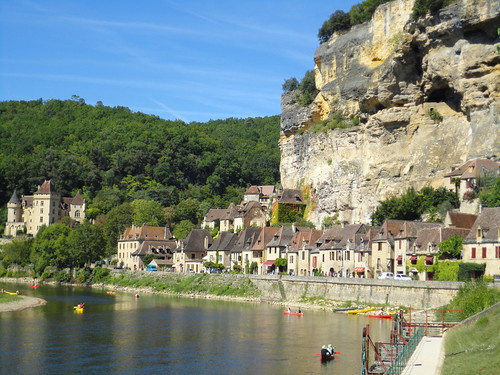 |
La Roque Gageac
|
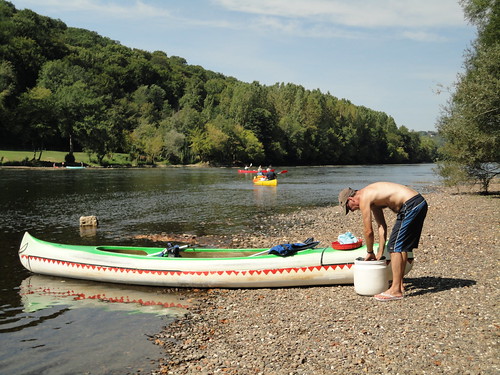 |
| Canoe pitstop, Dordogne River |
The romance of it is shattered, however. Two captains in one vessel is a surefire recipe for disaster. We bicker over strategy. He says I’m paddling too much, too little, not enough. I say he’s paddling too hard, too soon, too late. We watch others pass us effortlessly in their canoes and kayaks through the slow-moving waters. Meantimes, our canoe gracefully pirouettes in circles as it pulls out of patches of small currents.
After the first 10 km we’re too tired to argue as fatigue sets in. We pull over to a spot of gravelly beach on the riverbank for a snack, a stretch and a truce then continue zigzagging in almost blissful silence for the remaining 4 km, taking in the serene landscape until we reach the canoe company’s base. Okay, so we’ve proved to ourselves that after a few attempts over the years at various aquatic activities we’re hopeless together on water. Relationship test over, this experience has finally sealed the deal for the end of any future couple’s watersports.
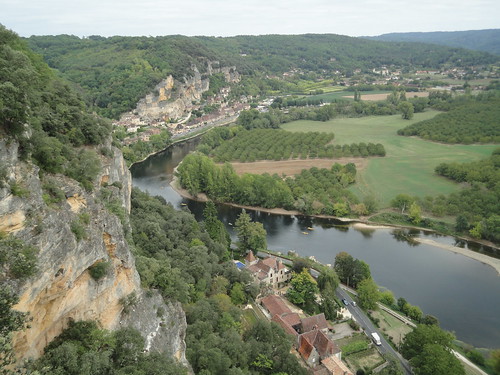 |
| View of Dordogne River |
We are in France’s Aquitaine region, between the Pyrenees in the south and Brittany and the Loire Valley to the north. Our base is the small village of Monpazier in the Aquitaine’s province of Dordogne. Also referred to as the Perigord, this area is divided into four counties – Perigord Blanc (white because of its limestone), Perigord Noir (Black Perigord because of the dark oak and pine forests), Perigord Pourpre (purple to represent the vineyard region) and Perigord Vert (Green Perigord due to the area’s verdant forests and valleys). Monpazier lies to the south in Perigord Pourpre where we’ve been sampling the fine red wines of Bergerac (of Cyrano Bergerac fame). We have rented a lovely two-storey renovated 13th century home in the centre of town that comes with a peaceful garden.
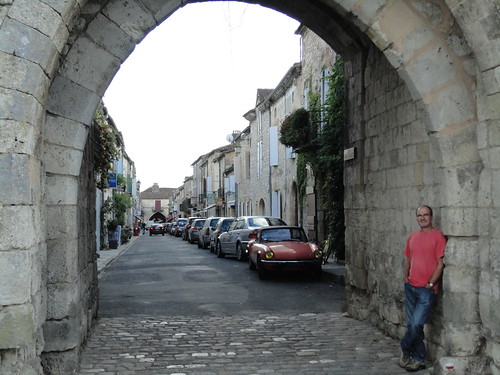 |
| Entry into town |
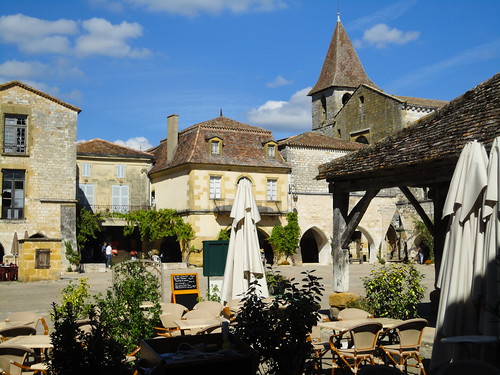 |
| Different building styles around the town square |
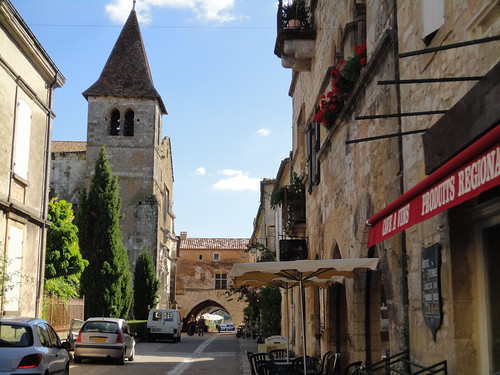 |
| Rue Notre Dame, Monpazier |
Within the medieval village, a narrow cobblestoned carreyrou (tiny alley) leads past a garden to the left, growing wild behind a stone wall with its tantalising smell of ripening figs. To the right, passing under a small stone arch we step across the gravel path to the house with its roses and wisteria vines clinging to the neighbours’ stone walls. Four bedrooms decorated with country-style furniture and two bathrooms are upstairs. From two of the bedrooms, views to the gardens below and out past the boundary walls of Monpazier to the gentle countryside beyond. The other two bedrooms overlook the street and a little restaurant opposite. Downstairs, French doors from the kitchen and living areas lead out to the courtyard garden, which is the perfect setting for a late afternoon glass of wine. It is one of the few properties in the village with a garden, a rarity. This is home to us for three weeks – the longest period we’d have stayed put on our 6 month journey.
 |
| The laneway to our house |
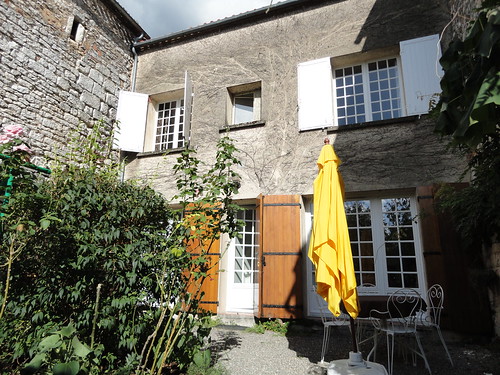 |
| Our retreat |
The caretaker, Amelia, shows us through the house and where to find things. She speaks not a word of English and we get along fine between my limited command of French and lots of gesturing and hands waving about. Max watches and tries to interpret the body language between us two ladies to make sense of how things work. The beds are typically French-sized – Napoleonic – and we’re lucky that either of us aren’t tall or big-framed. In bed we’re snug as two bugs in a rug. Treading the wooden floorboards in the dead of night creates a cacophony of little creaks and squeaks ensuring that both of us awake to hear the other’s nocturnal trip to the bathroom.
So the house is antique and creaky, but we’re loving it! We’re steps away from the main square. The things that a traveller appreciates are all here - a washing machine (no more hand scrubbing of socks and undies in a hotel basin for a while), a fully equipped kitchen for stay-at-home meals (hard to believe, I know, but one does get tired of dining out every day) and taking out freshly laundered and ironed clothes hanging in a cupboard rather than shaking out the creases from stale clothes folded in a backpack.
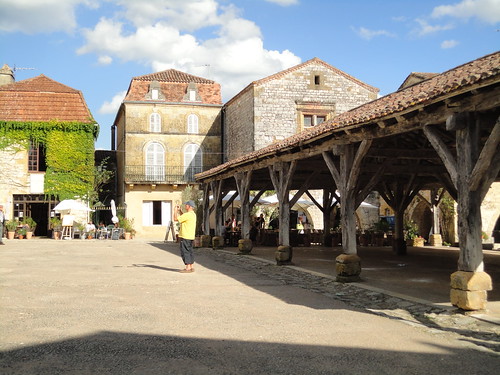 |
| Town square and market hall |
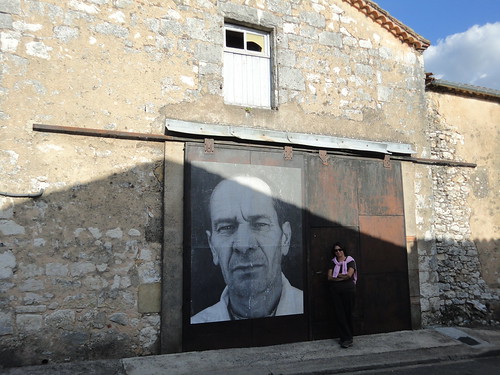 |
Interesting photographic exhibition of local villagers
displayed in large scale on public buildings around town |
Dinner of tinned cassoulet from Carrefour one of France’s largest supermarket chains, a good Bergerac red to wash it down (in other words, Draino to clear the fatty palate) and crisp French bread to sop up the juices is one of our first in-house meals. Cassoulet is a thick hearty stew from the Languedoc region in the south of France and is usually made with white beans, goose and/or duck fat, duck pieces, pork sausage and sometimes bacon. You get the idea - this is not a Weight Watcher’s meal. Very enjoyable but be warned - tinned cassoulet does not burp up very well.
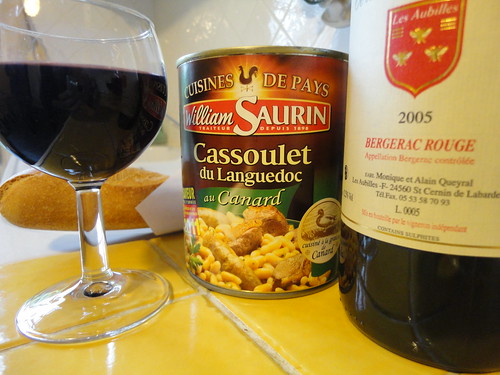 |
| Cheap French meal |
Monpazier’s history stretches back to the 1200’s when it was founded by King Edward I. It is considered one of the best preserved bastide towns in France, that is, a medieval fortified village with its strong walls and arched gateways still standing. In the arcaded town square ancient timbers hold up the open market hall that is still used to this day for markets. Just like its range of historic buildings, some things haven’t changed over time. Every Thursday is market day as it has been for centuries, when the town comes out of its inert state and livens up. We’ve bought good quality fresh produce such as luscious French cheeses, locally-made dry sausages of pork, bull or duck, honey, excellently priced wines and fruits and vegetables that stretch across outdoor trestles alongside arts and crafts stalls. We’ve even enjoyed some tasty Asian foods by a Vietnamese couple who load up their car and go from village market to village market in the area selling their freshly cooked products.
Three boulangeries in town (which incidentally take it in turn to close on alternate days - how thoughtful), ensure that we have ready access to freshly-baked delicious bread and croissants that come with a sing-song “bonjour, madame” and a smile from charming shop assistants each morning. I have fallen in love with warm pain au chocolat (a chocolate-embedded pastry similar to a croissant) here in Monpazier. In recent weeks we have eaten loads of European bread (ie, Greece, Italy & France) and not felt the ill-effects of it, like back home.
 |
| Flea market, Monpazier |
Each time we take a walk around the village we discover more of its hidden surprises. Like being on a treasure hunt, we notice little architectural details and unearth interesting historical facts and figures that are subtly presented on plaques down alleyways and on old stone facades. For instance, the width of the few main roads through the gateways were designed to be wide enough to allow two carts to pass side by side to allow trade in and out of the community.
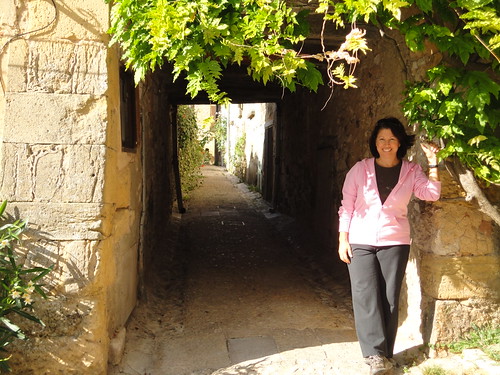 |
| Narrow laneways waiting to be explored |
On non-market days Monpazier falls into a kind of fairytale slumber. Like many rural places in France, the village opens for 3 hours in the morning and 3 hours in the afternoon. It means having to plan ahead and be organised before the supermarkets, bakeries, post office, library (for internet access) and shops close. On Wednesdays much of the village closes up for a day off. To an outsider the French 35-hour working week, whilst frustrating for tourists, presents as an envious condition of employment.
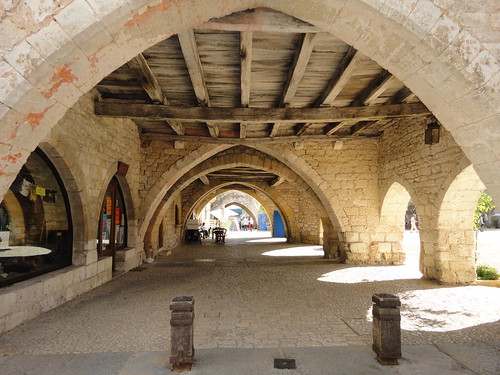 |
| Arcades around town square |
Locals are puzzled as to why Monpazier attracts many Australians throughout the year. Tourists come here from many European destinations, including French nationals, but there seems to be a disproportionate number of Aussies visiting. Maybe it has something to do with the village highlighted in Lonely Planet guidebooks. Who knows? It certainly oozes romantic historical charm in its rustic setting which is what attracted us here to this part of the Dordogne.
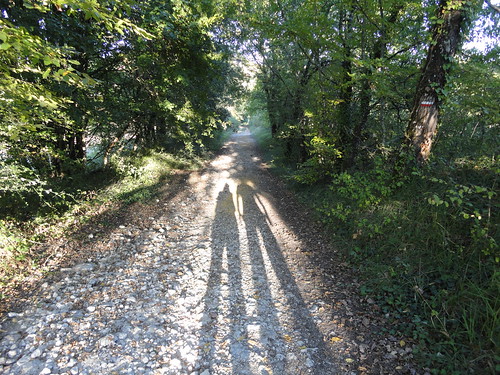 |
| Our shadows fall across a country lane |
Maybe it's the relaxed lifestyle that's so appealing around these parts. Sitting in the town square soaking up the warmth of the sun over a café au lait or creamy hot chocolate at one of several cafes, depending on where the autumn sunshine falls, has to be one of Monpazier’s best pastimes. Outside the village periphery, we explore the quiet country laneways and the surrounding farmsides on foot. By car, driving out of the village walls, we notice the same 4 men sitting on the same bench in front of the same street most mornings. Life in the fast lane, a la Monpazier style. Stress and speed don't seem to be a way of life here.
Minutes away by car is the lovely fortified medieval town of Belves where we’ve gone underground into fascinating troglodyte limestone caves that still exist below the town’s marketplace and streets. These were used for dwellings by the poorest of poor since the Middle Ages and earlier. Permanently etched in my mind is the horror of learning that in these dark, dank places some families were smart enough to suspend their babies’ cradles from hooks set into the stone ceiling to protect their young ones from rats that would eat away at babies’ ears and noses. In fact, a number of babies would have grown up with those body parts missing, thanks to hungry scavenging rodents. How gruesomely ghastly!
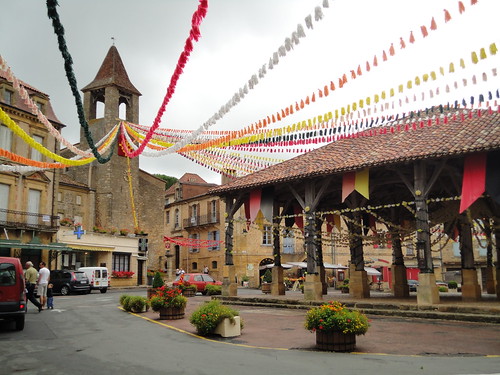 |
| Troglodyte caves lie directly below this street in Belves' market square. |
The Dordogne is heaving with chateaux yearning to be explored. One of our favourites in the area is Chateau des Milandes, once owned by the famous Afro-American 1920’s dancer, Josephine Baker. This castle is now a tribute to her and her life with many of her costumes, photographs and posters on display. In between scandalising and tantalising Paris in her skirt of bananas as a Les Folies dancer and adopting 12 children of different nationalities (Brangelina aren’t doing anything new) she campaigned for black civil rights and worked secretly for the French Resistance in WWII. Josephine Baker’s songs are played in the background as you stroll from room to room, and it was actually rather delightful to hear little old French ladies in tour groups walking by singing along to her music.
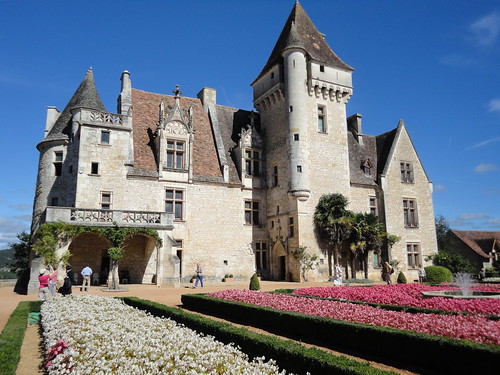 |
| Chateau des Milandes |
Our impressions to date – goodness gracious, coming from Australia we’re bowled over by how cheap the food and top quality wines are. The small grower is king here. High quality produce over quantity, and quality over profit is evident. A big thumbs up to small local French producers who are out there selling their products. The cost of living is infinitely cheaper than back home. My local village haircut, colour and style was an unbelievable 40 euros (about AUD$55) and I was very happy with it.
We’ve dined on the most amazing meals. A local restaurant, Bistrot 2, serves up the most incredible, almost orgasmic TO--DIE--FOR foie gras (we are in goose county after all) garnished with merlot-marinated sea salt and red wine onion relish washed down with a very enjoyable French champagne. Don't want to think about cholesterol levels till the party's over. Fine dining quality at West Australian café prices. Our money is certainly stretching further than anticipated.
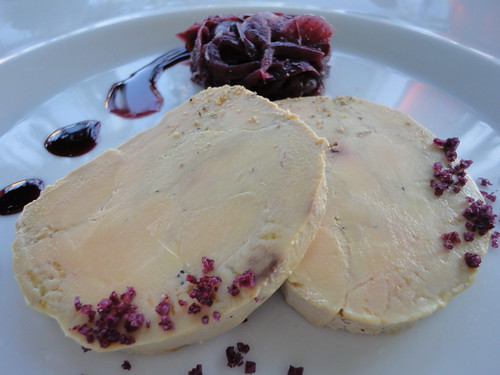 |
| Divine flavours of foie gras |



















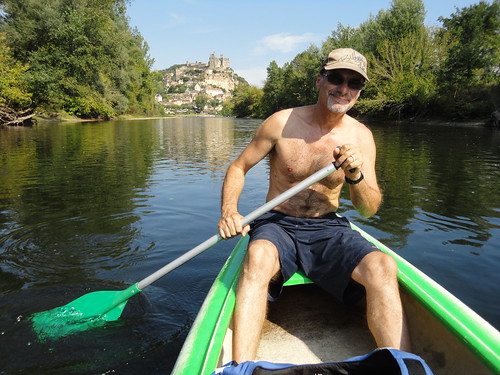

 Hi, I'm Eva - world traveller, cultural explorer and experience seeker. Together with my husband Max, we've been globetrotting for over 20 years.
Hi, I'm Eva - world traveller, cultural explorer and experience seeker. Together with my husband Max, we've been globetrotting for over 20 years.







0 comments: